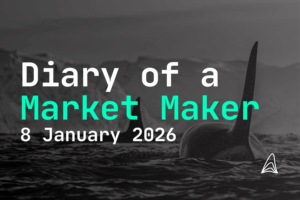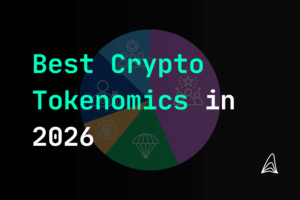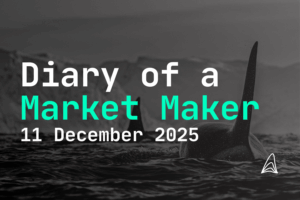
Tokenomics: Understanding the Economics of Cryptocurrencies
- Jakob Brezigar
- Last updated: 25.July 2024
- Reading time: 9 min
Cryptocurrency: where the coins are digital, the wallets are virtual, and understanding the economics can feel like deciphering a sci-fi novel! Welcome to the wild world of tokenomics, where supply and demand characteristics make or break a token’s value. In essence, tokenomics is the study of how tokens are created, distributed, and used within their ecosystems, impacting their utility, scarcity, and overall appeal.
As part of the evolution of token launch strategies, initial coin offerings (ICOs) have played a significant role, alongside security token offerings (STOs) and initial exchange offerings (IEOs).
Dive in as we unravel the complexities of tokenomics and explore what makes these digital assets tick!

Table of Contents
What is tokenomics?
Tokenomics is the study of how cryptocurrency tokens are created, distributed, and utilized within an ecosystem. It examines supply and demand, utility, and overall economic models to understand a token’s value.
Why is understanding tokenomics important?
Understanding tokenomics is crucial for investors, developers, and users as it affects a cryptocurrency’s utility, scarcity, and market value. It helps stakeholders make informed decisions and ensure long-term sustainability.
How do liquidity providers like Orcabay benefit from knowing tokenomics?
Liquidity providers like Orcabay use tokenomics to manage and stabilize token prices, ensuring sufficient liquidity. This knowledge helps them anticipate market movements and adjust strategies for balanced token supply.
Key Takeaways - Tokenomics:
Tokenomics studies how tokens are created, distributed, and used, impacting their utility, scarcity, and value.
Understanding token supply and demand is crucial for investors, developers, and users.
Effective tokenomics includes clear maximum token supply, fair allocation, and strategic inflation control.
Market makers like Orcabay must know tokenomics to provide sufficient liquidity and stabilize token prices.
Governance tokens enable decentralized decision-making, boosting investor confidence and community engagement.
What is Tokenomics?
Tokenomics is the study of the supply and demand characteristics that make a cryptocurrency valuable and appealing to investors. This field encompasses the economic models and principles governing the creation, distribution, and utilization of tokens within a blockchain ecosystem. By analyzing these factors, stakeholders can better understand how cryptocurrencies derive their value, how they are likely to behave in the market, and what potential they have for long-term sustainability.
Understanding tokenomics is crucial for potential investors, developers, and users, as it significantly impacts each cryptocurrency’s utility, scarcity, and value proposition. Investors need to grasp the nuances of token supply, inflation mechanisms, and market demand to make informed decisions. Developers must design robust tokenomics to ensure the viability and attractiveness of their projects, while users benefit from understanding how tokenomics affects their interactions within the ecosystem. The initial token supply plays a significant role in shaping market perception and managing the value of tokens at launch. Ultimately, tokenomics is a fundamental aspect of the crypto world that drives investment decisions, development strategies, and user engagement.
Token Fundamentals
In the world of cryptocurrencies, there are different types of tokens, each serving specific purposes within their ecosystems. Utility tokens give the holder the right to access or use a specific product or service within an ecosystem. These tokens are essential for operating within decentralized applications and platforms, as they facilitate interactions and transactions. Security tokens, on the other hand, are employed within networks to incentivize users through rewards or discounts.
These tokens often represent ownership stakes or shares in a project, akin to traditional securities. Governance tokens grant holders voting rights or decision-making authority over the evolution and operations of a blockchain network or decentralized platform. These tokens play a vital role in maintaining decentralization and community involvement in the development process, allowing token holders to influence key decisions and ensure the project’s alignment with their interests.
Understanding the distinctions between these token types is critical for anyone participating in the crypto space, as it informs their investment strategies and engagement levels. Each token type comes with its unique set of benefits, risks, and implications, making a thorough understanding of token fundamentals essential for navigating the complex landscape of digital assets.
Why Crypto Market Makers Have to Know Tokenomics Thoroughly
Crypto market makers must thoroughly understand tokenomics to effectively manage liquidity and stabilize token prices. By grasping the intricacies of token supply, demand characteristics, and distribution, liquidity providers like Orcabay can ensure sufficient liquidity at both initial and latter stages. This knowledge enables us to anticipate market movements, adjust our strategies, and maintain a balanced token supply. Orcabay’s employees’ expertise in tokenomics allows us to provide consistent liquidity, fostering a healthy trading environment, minimizing volatility, and boosting investor confidence in the token’s long-term viability and market stability.

Token Supply and Distribution
Maximum Token Supply
The concept of maximum token supply is fundamental in tokenomics. The maximum supply sets a hard cap on the number of tokens that can ever exist. This cap is predetermined and cannot be altered, ensuring that the total number of tokens remains fixed. The regulation of the token’s supply through smart contracts further ensures that the supply is managed transparently and predictably. A higher maximum supply can lead to inflation and reduce the token’s value. Conversely, a lower maximum supply can create scarcity, potentially increasing the token’s value as demand grows. Understanding the maximum supply is crucial for investors as it directly affects the token’s market dynamics.
Additionally, the maximum supply often influences investor perception and confidence, as a clearly defined limit can signal a controlled and predictable supply. This predictability is particularly important in contrast to traditional fiat currencies, which can be subject to arbitrary inflationary policies by central banks. In the context of tokenomics, a well-defined maximum token supply helps create a transparent and stable economic environment, fostering long-term trust and stability in the cryptocurrency market.

Tokens Allocated
Token allocation concerns the detailed allocation and fixed supply of tokens to various investor groups. This allocation is typically outlined in the project’s whitepaper and is crucial for ensuring transparency and fairness. A fair token allocation usually reserves a smaller portion of the maximum supply of tokens for insiders, such as the founding team and early investors.
This approach helps in building trust within the community and avoiding potential conflicts of interest. Proper token allocation is essential for maintaining a balanced and equitable ecosystem. The allocation strategy also involves distributing tokens to incentivize early adopters, developers, and other key stakeholders, ensuring that all participants are aligned with the project’s goals.
Furthermore, token allocation strategies often include vesting schedules to prevent large sell-offs by insiders, which can destabilize the market. By carefully managing token allocations, projects can foster a more resilient and supportive community, laying the groundwork for long-term success.

Token Holders
Token holders can be categorized into large institutions, retail investors, and the founding team. The distribution of tokens among stakeholders is thought out in advance, making it difficult to alter the issuance schedule and distribution plan. This planned distribution helps in maintaining stability within the ecosystem and prevents market manipulation. Large institutions often hold significant portions of tokens, contributing to the token’s stability and liquidity.
Retail investors and the founding team also play crucial roles in the ecosystem, each contributing to the project’s growth and development. The behavior and expectations of token holders can significantly impact a token’s market performance. For instance, institutional holders might focus on long-term investment strategies, while retail investors could be more prone to speculative trading.
Understanding the composition and behavior of token holders is vital for predicting market trends and assessing the overall health of the cryptocurrency. Additionally, fostering a diverse and engaged token holder base can enhance the project’s resilience against market volatility and external shocks.
Token Utility and Value
Token Use Cases
Token utility refers to the specific use or purpose a token serves within its ecosystem. Good token utility aligns with the project’s goals, adds genuine value, and encourages user participation. For instance, utility tokens can be used to access services, pay for transactions, or participate in network governance. The utility of a token directly influences its demand and, consequently, its value. Projects with strong use cases for their tokens tend to attract more users and investors, enhancing the overall ecosystem’s vibrancy and sustainability.
Effective token utility not only drives user engagement but also promotes network effects, where the value of the network increases as more people use and participate in it. Furthermore, the versatility of a token’s use cases can determine its resilience and adaptability in the ever-evolving crypto landscape. By continually expanding and refining token use cases, projects can maintain relevance and competitiveness, ensuring long-term viability and growth.
Token Inflation
Token inflation occurs when the supply of tokens increases, potentially reducing the token’s value. A token’s inflation rate can be controlled through mechanisms like token burns and fixed supply. Token burns are designed to permanently remove coins or tokens from circulation, reducing the overall supply and mitigating inflation. Maintaining a low and predictable inflation rate is crucial for preserving a token’s value over time.
Projects that effectively manage inflation tend to instill greater confidence among investors and users. Inflation management can also involve implementing deflationary mechanisms, such as periodic buybacks or dynamic supply adjustments based on network activity. These strategies help maintain a balance between token supply and demand, ensuring price stability and long-term value appreciation. By carefully designing and implementing these mechanisms, projects can create a sustainable economic model that supports growth while minimizing the risks associated with excessive token supply.
Token Economics
Market Capitalization
Market capitalization is a crucial measure representing the cumulative value of all mined coins. It is calculated by multiplying the total circulating supply of tokens by the current market price of each token. A higher market cap or capitalization suggests more stability in a cryptocurrency, making it a potentially safer investment option.
Market capitalization is an essential metric for comparing the relative size and health of different cryptocurrencies. Investors often use market cap to gauge a project’s potential for growth and its overall market position. Additionally, market capitalization can provide insights into the liquidity and maturity of a cryptocurrency, indicating its ability to withstand market fluctuations and external pressures.
A robust market capitalization often attracts more institutional investors, further enhancing the token’s stability and market confidence. By monitoring and analyzing market capitalization trends, stakeholders can make informed decisions about their investments and strategies, aligning them with the broader market dynamics.

Transaction Fees
Transaction fees can significantly influence a token’s value. High transaction fees can deter users from making transactions, potentially reducing the demand and value of a cryptocurrency. Conversely, low transaction fees can encourage more frequent use of the network, increasing the token’s utility and demand. Projects that optimize transaction fees to balance network security and user affordability tend to achieve greater adoption and success.
Transaction fees are a critical aspect of a token’s economic model and should be carefully considered in the tokenomics framework. Furthermore, transaction fees can be used as a tool to incentivize certain behaviors within the network, such as faster processing times for higher fees or discounted rates for frequent users. By designing a flexible and user-friendly fee structure, projects can enhance the overall user experience and drive more significant engagement and participation.
Additionally, transparent and predictable fee mechanisms help build trust and credibility within the community, fostering long-term loyalty and support.

Token Security and Governance
Smart Contracts
Smart contracts can serve as effective supply regulators by adjusting a token’s supply in real-time to trigger conditions like token velocity, total supply, and market price. These self-executing contracts with the terms of the agreement directly written into code enable automated and transparent transactions. Smart contracts are essential for implementing complex tokenomics models that require dynamic adjustments.
They enhance security and efficiency within the ecosystem, reducing the need for intermediaries and minimizing the risk of human error. By leveraging smart contract functionality, projects can create sophisticated and adaptable economic systems that respond to real-time market conditions. This adaptability is crucial for maintaining the stability and competitiveness of a cryptocurrency, as it allows the project to adjust to evolving market demands and technological advancements.
Furthermore, smart contracts can enhance user trust by ensuring that all transactions and changes within the network are transparent and tamper-proof, thereby reinforcing the integrity and reliability of the project.
Governance Tokens
Governance tokens grant holders voting rights or decision-making authority over the evolution and operations of a blockchain network or decentralized platform. These tokens enable decentralized governance, allowing community members to propose and vote on changes to the network. Governance tokens can impact a project’s market capitalization by stoking investor confidence and incentivizing active community engagement.
Projects that effectively utilize governance tokens can achieve a higher degree of decentralization and foster a more engaged and loyal user base. The distribution and utilization of governance tokens must be carefully managed to ensure fair representation and avoid centralization of power. By fostering an inclusive and transparent governance model, projects can enhance their resilience and adaptability, ensuring long-term sustainability.
Additionally, active and meaningful participation from the community in governance processes can drive innovation and improvement, aligning the project’s evolution with the needs and expectations of its users.

Evaluating Tokenomics
Competitive Analysis
Evaluating tokenomics involves a comprehensive analysis of a project’s token supply, distribution, utility, and economics. This analysis helps investors and stakeholders understand the strengths and weaknesses of a project compared to its competitors. By examining various tokenomics models, one can identify the most sustainable and promising projects. A thorough understanding of tokenomics is essential for making informed investment decisions and for developers to design robust and efficient economic models for their projects.
Competitive analysis also involves benchmarking a project’s performance against industry standards and trends, identifying potential opportunities and threats. By staying informed about the latest developments and best practices in tokenomics, stakeholders can adapt their strategies to maintain a competitive edge.
Also one must know that a detailed competitive analysis can reveal gaps and inefficiencies in the market, guiding the development of innovative solutions that address unmet needs and create new value propositions.
Red Flags and Green Flags
When evaluating tokenomics, it is important to identify red flags and green flags. Red flags include poor token allocation, high inflation rates, and lack of transparency. These issues can indicate potential risks and challenges within the project. On the other hand, green flags include a well-structured token economy, fair token allocation, and a strong use case.
These positive indicators suggest a project’s potential for success and sustainability. Investors should look for green flags and avoid projects with significant red flags to mitigate risks and maximize returns. Additionally, conducting thorough due diligence and seeking expert opinions can help identify subtle red flags that may not be immediately apparent.
By focusing on projects with robust tokenomics and avoiding those with significant red flags, investors can enhance their chances of achieving long-term success and minimizing potential losses. It is also beneficial to engage with the community and project team to gain deeper insights into the project’s vision, execution capabilities, and overall credibility.

Tokenomics in Practice
Token Burns
Token burns are designed to permanently remove coins or tokens from circulation. This process can help reduce the total supply of tokens, counteracting inflation and supporting the token’s value. Token burns can demonstrate a project owner’s commitment to reducing the supply and enhancing the value of their tokens. By regularly burning tokens, projects can maintain scarcity and potentially increase demand, benefiting token holders in the long run.
The mechanics of token burns involve sending tokens to a verifiably unspendable address, ensuring they can never be used again. This approach not only helps in controlling inflation but also signals to the market that the project is actively managing its token supply. Furthermore, token burns can create a deflationary effect, potentially driving up the token’s price as supply decreases. By strategically planning and executing token burns, projects can align their tokenomics with long-term value creation goals, enhancing investor confidence and market performance.
Mining and Staking
Mining and staking are critical components of a token’s economics, influencing the token’s supply and distribution. Mining involves validating transactions and adding them to the blockchain, earning new tokens as rewards. Staking, on the other hand, involves holding tokens in a wallet to support network operations, earning rewards in return. Both mechanisms contribute to the token’s security and decentralization.
The consensus layer upgrade is moving Ethereum towards a staking model, highlighting the growing importance of staking in the crypto ecosystem. Mining and staking also play pivotal roles in the network’s consensus mechanisms, ensuring the integrity and reliability of the blockchain. As the industry evolves, staking is becoming increasingly popular due to its lower energy consumption and greater accessibility compared to traditional mining.
By participating in mining and staking, token holders can actively contribute to the network’s security and earn rewards, aligning their interests with the long-term success of the project. Furthermore, these mechanisms help distribute tokens more broadly, promoting decentralization and reducing the risk of centralization of power within the network.
The Future of Tokenomics
The crypto landscape is constantly evolving, with new models and strategies emerging. Tokenomics will continue to play a crucial role in shaping the success and sustainability of cryptocurrency projects. As the industry matures, we can expect more sophisticated tokenomics models that better align incentives, enhance security, and promote long-term value creation. Innovations in tokenomics will drive the next wave of growth and adoption in the crypto space, providing new opportunities and challenges for developers, investors, and users.
These innovations may include novel mechanisms for token distribution, advanced governance models, and more efficient ways to manage inflation and deflation. Additionally, the integration of artificial intelligence and machine learning could lead to more adaptive and responsive tokenomics, optimizing economic models in real-time based on market conditions and user behavior. By staying at the forefront of these developments, stakeholders can capitalize on emerging trends and technologies, ensuring their projects remain competitive and resilient in the dynamic crypto landscape.
Conclusion About Tokenomics
Tokenomics is a complex field that underpins the cryptocurrency ecosystem’s economic framework. Understanding tokenomics is essential for investors, developers, and users, as it significantly impacts each cryptocurrency’s utility, scarcity, and value proposition. By studying the various aspects of tokenomics, stakeholders can make informed decisions, contribute to the development of robust economic models, and participate in the growth and success of the crypto industry.
As crypto continues to evolve, tokenomics will remain a critical factor in determining the viability and sustainability of cryptocurrency projects. By mastering the principles of tokenomics, stakeholders can navigate the complexities of the crypto market, identify promising opportunities, and mitigate potential risks. Ultimately, a deep understanding of tokenomics is key to unlocking the full potential of cryptocurrencies and driving the continued innovation and growth of the blockchain ecosystem.
Disclaimer: The information provided in this article is for informational purposes only and does not constitute financial, investment, or other professional advice. All opinions expressed herein are solely those of the author and do not represent the views or opinions of any entity with which the author may be associated. Investing in financial markets involves risk, including the potential loss of principal. Readers should perform their own research and consult with a licensed financial advisor before making any investment decisions. Past performance is not indicative of future results.

Jakob Brezigar
Jakob, an experienced specialist in the field of cryptocurrency market making, boasts an extensive international presence. With Orcabay, he has skillfully managed major operations and deals for a wide array of global stakeholders.



